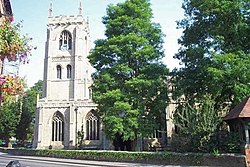Kirton in Holland
| Kirton in Holland | |
| Lincolnshire | |
|---|---|
 Church of St Peter and St Paul, Kirton | |
| Location | |
| Grid reference: | TF304385 |
| Location: | 52°55’40"N, 0°3’35"W |
| Data | |
| Population: | 4,019 |
| Post town: | Boston |
| Postcode: | PE20 |
| Dialling code: | 01205 |
| Local Government | |
| Council: | Boston |
| Parliamentary constituency: |
Boston and Skegness |
Kirton in Holland or just Kirton is a village in Lincolnshire, in Holland, the southeastern part of the county.
Kirton is on the A16 south of Boston, near Frampton and Sutterton. Several satellite villages and hamlets take their name from Kirton, in the fenland style, including Kirton Holme, Kirton End, Kirton Fen, Kirton Skeldyke, and Kirton Marsh. Until 1970, the village had the Kirton railway station.
Kirton falls within the drainage area of the Black Sluice Internal Drainage Board.[1]
Parish church
The parish church is dedicated to St Peter & St Paul.
The transepts had double aisles like those of Algarkirk and Spalding but in 1804 the central tower and transepts were pulled down and the chancel shortened, the architect (Hayward) using gunpowder to remove the tower. Rebuilding was completed by 1809. In 1900 a restoration of the church was undertaken by architect Hodgson Fowler.[2]
History
Kirton was the seat of Lincolnshire's first English kings, later becoming a market town.[3]
In the Domesday Book account the village is written as "Cherchetune". It consisted of 52 households, with 30 freemen and 16 smallholders, 12 ploughlands, 10 plough teams, a meadow of 60 acres, a church and 2 salthouses. After the Conquest the lordship of the manor was held by Earl Ralph, and it was transferred to Count Alan of Brittany in 1086.[4][5]
In 1885 Kelly's Directory recorded the village as having a station on the Great Northern Railway. There existed Congregational and Wesleyan chapels and almshouses for four poor women. The village market was then disused. The Gas Consumers' Company Ltd was formed here in 1865. Principal landowners were The Mercers' Company, Sir Thomas Whichcote DL, E R C Cust DL, the Very Rev Arthur Percival Purey-Cust DD, and Samuel Smeeton, whose residence was the "modern white building" of D'Eyncourt Hall. Agricultural production within the 8,962 acres parish consisted of wheat, beans and potatoes, and there was a "large quantity of pasture land" and 676 acres of marshland. The 1881 the ecclesiastical parish population was 2,011, the civil parish, 2,580.[6]
Grammar school
In 1624 Thomas (later Sir Thomas) Middlecott was empowered by a Private Act of Parliament to found a Free Grammar School for the instruction of Latin and Greek language, and English commercial and agricultural education, to children from the parishes of Kirton, Sutterton, Algarkirk and Fosdyke. By 1835 the school had 40 pupils, partly free and partly fee-paying. The (head) master appointed in 1773, Rev. Charles Wildbore (c1736-1802), and later his son by the same name (1767-1842), were alleged to have been diverting surplus income from the school's endowments for their own use, and failing to properly maintain educational standards. This culminated in a Parliamentary report, and the management of the school was ultimately restructured in 1851. By 1885 William Cochran was the master, and a new school house had been erected adjacent to his residence.
Under a scheme of the Endowed School Act, amended in 1898, the school was ranked as a "second-grade" Grammar School.[6][2][7][8]
In the 1830s a girls' school for 14 day and boarding pupils, and a Sunday School for 32 males and 16 females existed in the village.[8]
The village now has a secondary modern school: the Middlecott School.
Research centre
The Kirton Research Centre, which was closed in 2009, was nearby. Ownership of the 120-acre centre was transferred from DEFRA to the University of Warwick in April 2004 and became part of Horticulture Research International. In August 2009 the University closed the centre as public and private funding failed to cover running costs.[9]
See also
Outside links
| ("Wikimedia Commons" has material about Kirton in Holland) |
- Parish council
- Kirton News
- Kirton Brass Band
- Sea Scouts
- Kirton Primary School
- Middlecott School
- Kirton Town Hall
References
- ↑ "Black Sluice IDB". http://www.blacksluiceidb.gov.uk/.
- ↑ 2.0 2.1 Cox, J. Charles (1916); Lincolnshire p. 187; Methuen & Co. Ltd.; retrieved 23 April 2011
- ↑ Kirton in Holland, GENUKI
- ↑ "Kirton", Domesdaymap.co.uk. Retrieved 20 April 2012
- ↑ "Documents Online: Kirton, Lincolnshire", Folio: 367v, Great Domesday Book; The National Archives
- ↑ 6.0 6.1 Kelly's Directory of Lincolnshire with the port of Hull 1885, pp. 504, 505
- ↑ Report of the commissioners appointed in pursuance of an act of Parliament made and passed in the 5th and 6th years of King William the 4th, c. 71, intituled, "an act for appointing commissioners to continue the inquiries concerning charities in England and Wales, until the first day of March one thousand eight hundred and thirty-seven"; P.P. 1839 [194] 32−−Part IV, 38
- ↑ 8.0 8.1 Great Britain. Parliament. House of Commons (1835); Parliamentary Papers, Volume 42, p. 527; BiblioBazaar, LLC (2010). ISBN 1144191092
- ↑ The Kirton Research Centre, University of Warwick
